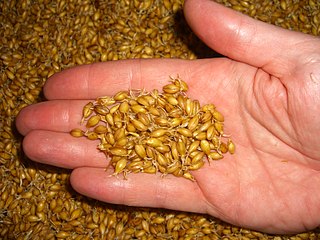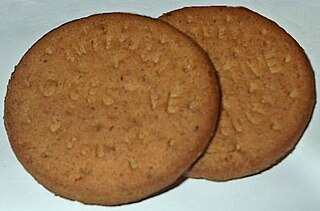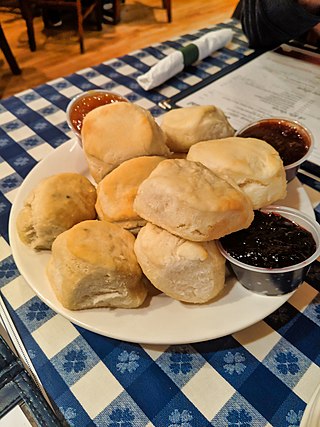
Malt is any cereal grain that has been made to germinate by soaking in water and then stopped from germinating further by drying with hot air, a process known as "malting". Malted grain is used to make beer, whisky, malted milk, malt vinegar, confections such as Maltesers and Whoppers, flavored drinks such as Horlicks, Ovaltine, and Milo, and some baked goods, such as malt loaf, bagels, and Rich Tea biscuits. Malted grain that has been ground into a coarse meal is known as "sweet meal".

Matzah, matzo, or maẓẓah is an unleavened flatbread that is part of Jewish cuisine and forms an integral element of the Passover festival, during which chametz is forbidden.

Bread is a staple food prepared from a dough of flour and water, usually by baking. Throughout recorded history and around the world, it has been an important part of many cultures' diet. It is one of the oldest human-made foods, having been of significance since the dawn of agriculture, and plays an essential role in both religious rituals and secular culture.

A digestive biscuit, sometimes described as a sweet-meal biscuit, is a semi-sweet biscuit that originated in Scotland. The digestive was first developed in 1839 by two doctors to aid digestion. The term digestive is derived from the belief that they had antacid properties around the time the biscuit was first introduced due to the use of sodium bicarbonate as an ingredient. Historically, some producers used diastatic malt extract to "digest" some of the starch that existed in flour prior to baking.
Wheat flour is a powder made from the grinding of common wheat used for human consumption. Wheat varieties are called "soft" or "weak" if gluten content is low, and are called "hard" or "strong" if they have high gluten content. Hard flour, or bread flour, is high in gluten, with 12% to 14% gluten content, and its dough has elastic toughness that holds its shape well once baked. Soft flour is comparatively low in gluten and thus results in a loaf with a finer, crumbly texture. Soft flour is usually divided into cake flour, which is the lowest in gluten, and pastry flour, which has slightly more gluten than cake flour.

Breadcrumbs, also known as breading, consist of crumbled bread of varying dryness, sometimes with seasonings added, used for breading or crumbing foods, topping casseroles, stuffing poultry, thickening stews, adding inexpensive bulk to soups, meatloaves and similar foods, and making a crisp and crunchy covering for fried foods, especially breaded cutlets like tonkatsu and schnitzel. The Japanese variety of breadcrumbs is called "panko".

Groats are the hulled kernels of various cereal grains, such as oats, wheat, rye, and barley. Groats are whole grains that include the cereal germ and fiber-rich bran portion of the grain, as well as the endosperm.

A flatbread is bread made usually with flour; water, milk, yogurt, or other liquid; and salt, and then thoroughly rolled into flattened dough. Many flatbreads are unleavened, although some are leavened, such as pita bread.

Rye bread is a type of bread made with various proportions of flour from rye grain. It can be light or dark in color, depending on the type of flour used and the addition of coloring agents, and is typically denser than bread made from wheat flour. Compared to white bread, it is higher in fiber, darker in color, and stronger in flavor. The world's largest exporter of rye bread is Poland.

Indian breads are a wide variety of flatbreads and crêpes which are an integral part of Indian cuisine. Their variation reflects the diversity of Indian culture and food habits.

Ghanaian cuisine refers to the meals of the Ghanaian people. The main dishes of Ghana are centered around starchy staple foods, accompanied by either a sauce or soup as well as a source of protein. The primary ingredients for the vast majority of soups and stews are tomatoes, hot peppers, and onions. As a result of these main ingredients, most Ghanaian jollof rice, soups, and stews appear red or orange.
The Chorleywood bread process (CBP) is a method of efficient dough production to make yeasted bread quickly, producing a soft, fluffy loaf. Compared to traditional bread-making processes, CBP uses more yeast, added fats, chemicals, and high-speed mixing to allow the dough to be made with lower-protein wheat, and produces bread in a shorter time. It was developed by Bill Collins, George Elton and Norman Chamberlain of the British Baking Industries Research Association at Chorleywood in 1961. As of 2009, 80% of bread made in the United Kingdom used the process.

Mash ingredients, mash bill, mashbill, or grain bill are the materials that brewers use to produce the wort that they then ferment into alcohol. Mashing is the act of creating and extracting fermentable and non-fermentable sugars and flavor components from grain by steeping it in hot water, and then letting it rest at specific temperature ranges to activate naturally occurring enzymes in the grain that convert starches to sugars. The sugars separate from the mash ingredients, and then yeast in the brewing process converts them to alcohol and other fermentation products.

A dough conditioner, flour treatment agent, improving agent or bread improver is any ingredient or chemical added to bread dough to strengthen its texture or otherwise improve it in some way. Dough conditioners may include enzymes, yeast nutrients, mineral salts, oxidants and reductants, bleaching agents and emulsifiers. They are food additives combined with flour to improve baking functionality. Flour treatment agents are used to increase the speed of dough rising and to improve the strength and workability of the dough.

In the United States, a biscuit is a variety of baked bread with a firm, dry exterior and a soft, crumbly interior. In Canada it sometimes also refers to this or a traditional European biscuit. It is made with baking powder as a leavening agent rather than yeast, and at times is called a baking powder biscuit to differentiate it from other types. Like other forms of bread, a biscuit is often served with butter or other condiments, flavored with other ingredients, or combined with other types of food to make sandwiches or other dishes.

Nordic bread culture has existed in Denmark, Finland, Norway, and Sweden from prehistoric times through to the present. It is often characterized by the usage of rye flour, barley flour, a mixture of nuts, seeds, and herbs, and varying densities depending on the region. Often, bread is served as an accompaniment to various recipes and meals. Nordic breads are often seasoned with an assortment of different spices and additives, such as caraway seeds, orange zest, anise, and honey.

















